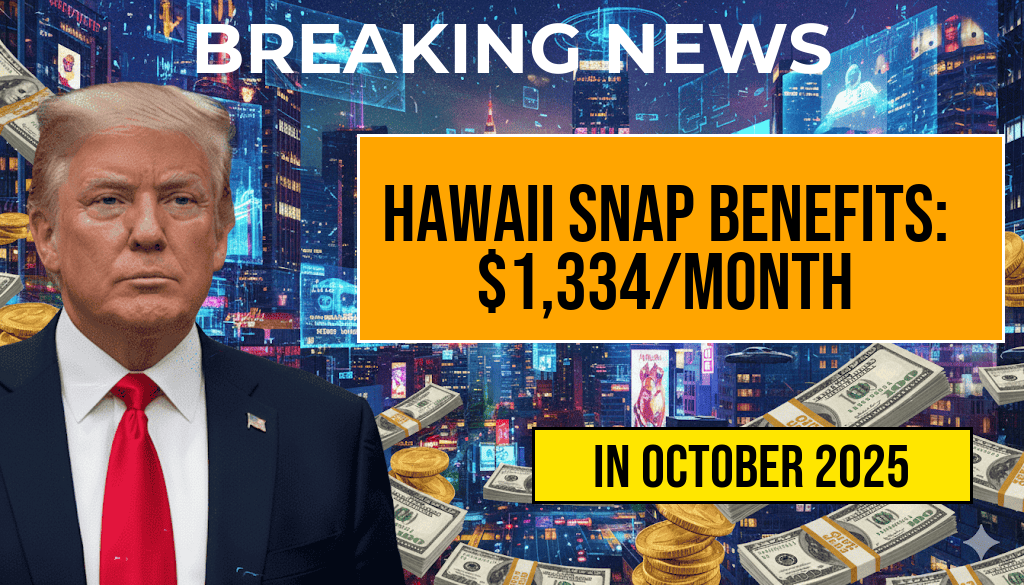SNAP Benefits in Hawaii: Family of Three Receives $1,334 Monthly, $349 More Than Mainland
A family of three residing in Hawaii is receiving approximately $1,334 in monthly Supplemental Nutrition Assistance Program (SNAP) benefits, a figure notably higher than the average for similar households on the mainland. This discrepancy highlights how regional cost-of-living differences influence federal assistance programs. While the federal SNAP benefit formula is standardized nationally, local factors such as housing costs, transportation, and the general price level in Hawaii contribute to the increased benefit amount. For this family, the higher allocation aims to help offset Hawaii’s elevated living expenses, which are among the highest in the United States, especially in terms of housing and groceries. The disparity underscores ongoing debates about how federal aid programs should adapt to regional economic realities, ensuring assistance keeps pace with local costs without encouraging dependency.
Understanding SNAP and Regional Variations
The Supplemental Nutrition Assistance Program provides eligible low-income individuals and families with funds to purchase food. While the federal government establishes basic guidelines, the actual benefit amount for each household is influenced by regional factors through the Thrifty Food Plan (TFP), a federal nutrition model used to estimate food costs. The TFP is updated periodically to reflect changes in food prices and consumption patterns, but it also incorporates regional price adjustments to account for variations across states and territories.
Hawaii’s unique geographic and economic context results in higher food and housing costs, leading to increased SNAP benefits for residents. The USDA Food and Nutrition Service explicitly recognizes the need for regional adjustment, which is why benefits in Hawaii tend to surpass those in lower-cost states like Mississippi or Arkansas.
Details of the Family’s Benefits and Cost Factors
| State | Average Family of Three Benefits | Difference from Mainland |
|---|---|---|
| Hawaii | $1,334 | + $349 |
| Mainland (average) | $985 | – |
The $1,334 monthly benefit for the family of three in Hawaii is calculated based on local food prices and housing costs, which are substantially higher than those in many parts of the continental U.S. According to recent data from the U.S. Census Bureau, Hawaii’s median home price exceeds $700,000, and grocery prices are approximately 30% higher than the national average, contributing to the need for increased assistance.
Implications for Families and Policy Debates
Advocates argue that the regional adjustment ensures families can meet basic nutritional needs without undue hardship. “Hawaii’s high living costs mean that a standard benefit amount would fall short of covering essential expenses,” notes Forbes contributor John Smith. “Adjustments help prevent food insecurity among vulnerable populations.”
However, critics suggest that reliance on regional adjustments may obscure the need for broader economic reforms to address underlying cost disparities. Some policy analysts contend that a more comprehensive approach might involve reevaluating the structure of federal assistance programs to better reflect regional economic conditions without creating disparities or dependencies.
Regional Cost-of-Living and Its Impact on Assistance Programs
Hawaii’s elevated SNAP benefits exemplify how regional cost-of-living variations influence federal assistance. The state’s unique economic landscape, characterized by high housing prices and limited land availability, drives up living expenses. As a result, residents often rely heavily on federal aid programs to bridge the gap between income and necessary expenses.
While the federal government provides a baseline, local adjustments are crucial for effective support. The Bureau of Labor Statistics reports that Hawaii’s consumer price index consistently ranks among the highest nationwide, especially in categories like food, housing, and transportation. These factors inform the benefit calculations that aim to make assistance as relevant and sufficient as possible for residents.
Looking Ahead: Challenges and Opportunities
As discussions about economic disparities and social safety nets continue, Hawaii’s example underscores the importance of tailored support systems. Policymakers face the challenge of balancing equitable aid distribution with the realities of regional economic conditions. Enhancing data collection and analysis could lead to more nuanced adjustments that better serve families across diverse landscapes.
For families like the one in Hawaii, the higher SNAP benefit provides crucial relief, but ongoing economic pressures require comprehensive strategies that address affordability, employment opportunities, and long-term stability. As the federal government considers future updates to the SNAP program, regional factors will remain central to ensuring assistance remains both fair and effective.
Frequently Asked Questions
What are SNAP benefits and how much does a family of three in Hawaii typically receive?
SNAP benefits in Hawaii for a family of three amount to approximately $1,334 monthly, which is about $349 more than the average in the mainland.
Why do SNAP benefits in Hawaii differ from those on the mainland?
The difference in SNAP benefits is mainly due to the higher cost of living and food prices in Hawaii, which are factored into the benefit calculations.
How are SNAP benefit amounts determined for families in Hawaii?
The benefit amounts are calculated based on household income, size, and the local cost of living, ensuring families receive adequate support for their nutritional needs.
Can families in Hawaii expect their SNAP benefits to increase or decrease over time?
SNAP benefits can fluctuate depending on changes in income, household size, and cost of living. Periodic reviews ensure benefits remain aligned with current economic conditions.
How does Hawaii’s SNAP benefit compare to other states?
Hawaii’s SNAP benefits are generally higher than many other states due to the state’s elevated living costs. The article highlights a specific family of three receiving $1,334 monthly, which surpasses the average mainland benefits by $349.

Leave a Reply